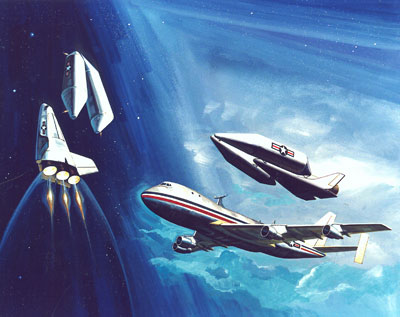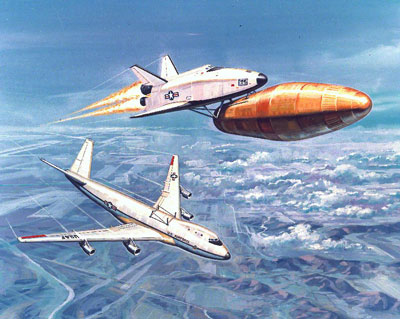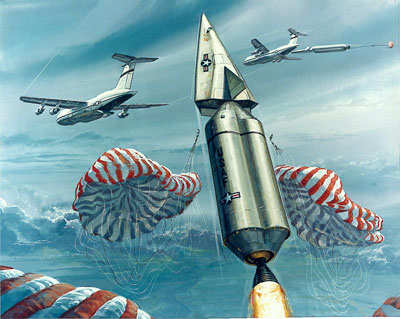Fire in the sky: the Air Launched Sortie Vehicle of the early 1980s (part 3)by Dwayne Day
|
| “We examined a wide variety of propellants ranging from storable hypergolics, RP/LOX, to fluorine/deuterium.” That may sound exotic, but Ehrlich joked that “this was a paper study!” |
Now imagine that instead of a relatively small rocket, there was a much larger rocket, with a pilot sitting in the nose, watching as he was pulled out of the back of a massive C-5 Galaxy cargo aircraft. And imagine that pilot falling backward, hundreds of feet, before a powerful Space Shuttle Main Engine ignited to push him into orbit. In the late 1980s Rockwell International, which built the Space Shuttle, proposed just such a system to the Air Force. According to Carl Ehrlich, an engineer for the company at the time, they had been inspired by footage of a 1974 test which involved dropping a Minuteman ICBM out the back of a C-5 and launching it. That test had proven successful, although the Air Force did not adopt the mobile ICBM concept. Ehrlich and other Rockwell engineers believed that there were certain advantages to air-launching a rocket, including rapid response and the ability to launch from virtually any location to any orbit.
The Air Force did not follow up on Rockwell’s proposal. But only a few years later, Don Hart of the Air Force Rocket Propulsion Laboratory proposed an Air Force Space Sortie Vehicle that incorporated the same general idea. (See: “Fire in the Sky: the Air Launched Sortie Vehicle of the 1980s (Part 1),” The Space Review, February 22, 2010, and “Fire in the Sky: the Air Launched Sortie Vehicle of the 1980s (Part 2),” The Space Review, March 8, 2010).
Rockwell’s C-5 based proposal used a single rocket engine mounted behind two joined tanks. According to Ehrlich, in addition to the SSME and its liquid oxygen/hydrogen combination, “we also explored the effect of differing propellants on the payload capability of the orbital vehicle. We examined a wide variety of propellants ranging from storable hypergolics, RP/LOX, to fluorine/deuterium.” That may sound exotic, but Ehrlich joked that “this was a paper study!” Nobody had to mess around with actual fluorine.
The spacecraft would have been manned, and was based on the FDL-5A lifting body shape. Ehrlich had worked on the FDL-5A for many years, ever since the mid-1960s. FDL stood for the Air Force’s Flight Dynamics Laboratory, and Ehrlich and others had been involved in testing the shape in wind tunnels and refining it over time. The FDL-5A looked like a spike: long, thin, and angular. The initial design had a single central fin. But over time the design evolved, adding a body flap at the bottom and deleting the single fin in favor of winglets. The final version had more rounded edges and a graceful look, sharing similarities with the HL-10 lifting body tested in the 1960s. That final version was Lockheed’s early 1970s Space Shuttle proposal.
 Rockwell concept for an air-launched spaceplane produced as part of the Advanced Military Spaceflight Capability study in the late 1970s/early 1980s. (Source: Carl Ehrlich) |
In December 1980, Don Hart of the Air Force Rocket Propulsion Laboratory at Edwards Air Force Base wrote a memo describing a proposed Air Force Space Sortie Vehicle that would be launched from the back of a 747. Ehrlich says that he knew Hart at the time, and that it is possible that Hart got the idea of the Space Sortie Vehicle concept from some work that Rockwell was then engaged in. “I’m not sure which came first, Don’s or ours, or they may even have been shared concepts,” Ehrlich remembers. He said that around 1978 or ’79 the Air Force was interested in a concept that they then called “On-Demand Launch.” Rockwell learned of the Air Force interest and began working on several concepts. In 1979, the Air Force initiated an Advanced Military Spaceflight Capability Technology Identification Study (known as AMSC) and Rockwell was ready for it. The AMSC study actually preceded and ran concurrently with the Air Force Space Sortie Vehicle outlined in Hart’s December 1980 memo.
| But Rockwell ran into the same limitations experienced by other companies that looked into the Sortie Vehicle Concept. Such a craft could only carry a relatively small payload. |
Ehrlich had taken his lifting body knowledge with him to Rockwell. The FDL-5A shape seen pulled out of the C-5 in the artist impression is the more angular version, with the single tail. But when Rockwell started working on the AMSC, they considered a spacecraft with drop tanks and mounted above a 747. The shape they used in that study was the more rounded version, with winglets. “Different mission, different shape, but retaining the critical aerodynamic features which were key,” Ehrlich explained. The craft could be wider because it did not have to fit inside an aircraft. The Rockwell craft also had three rocket engines in its tail.
The Rockwell approach was to use the V-shaped drop tank only for hydrogen. The spacecraft itself would carry both oxygen and a little bit of hydrogen for the final push into orbit. This simplified the tank design, and since the tank was the expendable part of the spacecraft that reduced cost.
 Rockwell concept produced for the Air Force Space Sortie Vehicle study (also known as the Air Launched Sortie Vehicle). (Source: Carl Ehrlich) |
As part of the Air Force Space Sortie Vehicle work, Rockwell considered a more conventional-looking craft, a spacecraft that looked like a smaller space shuttle, with a single large tank. The same approach was also adopted by Boeing in its Air Launched Sortie Vehicle study. Rockwell’s design had the 747 fitted with a V-tail, to avoid the exhaust plume from the spaceplane’s rocket engine. Rockwell also looked at an even more exotic idea involving an air-cushioned sled powered by jet engines. This approach allowed the spacecraft to have smaller wings and lighter landing gear than a more conventional take-off approach.
But Rockwell ran into the same limitations experienced by other companies that looked into the Sortie Vehicle Concept. Such a craft could only carry a relatively small payload. But it also required drop tanks, and that increased the expense. The Air Force wanted a cheaper vehicle and the only way to achieve that would be to develop one that was fully reusable.
Next: The Boeing study.
